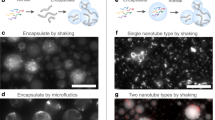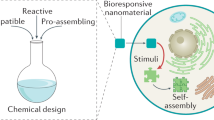Abstract
Achieving triggered release of small molecules with spatial and temporal precision at designated cells within an organism remains a challenge. By combining a cell-targetable, icosahedral DNA-nanocapsule loaded with photoresponsive polymers, we show cytosolic delivery of small molecules with the spatial resolution of single endosomes in specific cells in Caenorhabditis elegans. Our technology can report on the extent of small molecules released after photoactivation as well as pinpoint the location at which uncaging of the molecules occurred. We apply this technology to release dehydroepiandrosterone (DHEA), a neurosteroid that promotes neurogenesis and neuron survival, and determined the timescale of neuronal activation by DHEA, using light-induced release of DHEA from targeted DNA nanocapsules. Importantly, sequestration inside the DNA capsule prevents photocaged DHEA from activating neurons prematurely. Our methodology can in principle be generalized to diverse neurostimulatory molecules.
This is a preview of subscription content, access via your institution
Access options
Access Nature and 54 other Nature Portfolio journals
Get Nature+, our best-value online-access subscription
$29.99 / 30 days
cancel any time
Subscribe to this journal
Receive 12 print issues and online access
$259.00 per year
only $21.58 per issue
Buy this article
- Purchase on Springer Link
- Instant access to full article PDF
Prices may be subject to local taxes which are calculated during checkout




Similar content being viewed by others
References
Aznar, E. et al. Gated materials for on-command release of guest molecules. Chem. Rev. 116, 561–718 (2016).
Mura, S., Nicolas, J. & Couvreur, P. Stimuli-responsive nanocarriers for drug delivery. Nat. Mater. 12, 991–1003 (2013).
Lee, M. H., Sessler, J. L. & Kim, J. S. Disulfide-based multifunctional conjugates for targeted theranostic drug delivery. Acc. Chem. Res. 48, 2935–2946 (2015).
Gao, W., Chan, J. M. & Farokhzad, O. C. pH-responsive nanoparticles for drug delivery. Mol. Pharm. 7, 1913–1920 (2010).
Lee, M. H. et al. Liposomal texaphyrin theranostics for metastatic liver cancer. J. Am. Chem. Soc. 138, 16380–16387 (2016).
Klán, P. et al. Photoremovable protecting groups in chemistry and biology: reaction mechanisms and efficacy. Chem. Rev. 113, 119–191 (2013).
Ellis-Davies, G. C. R. Caged compounds: photorelease technology for control of cellular chemistry and physiology. Nat. Methods 4, 619–628 (2007).
Oh, W. C., Lutzu, S., Castillo, P. E. & Kwon, H.-B. De novo synaptogenesis induced by GABA in the developing mouse cortex. Science 353, 1037–1040 (2016).
Shi, D. D., Trigo, F. F., Semmelhack, M. F. & Wang, S. S.-H. Synthesis and biological evaluation of bis-CNB-GABA, a photoactivatable neurotransmitter with low receptor interference and chemical two-photon uncaging properties. J. Am. Chem. Soc. 136, 1976–1981 (2014).
Ellis-Davies, G. C. A chemist and biologist talk to each other about caged neurotransmitters. Beilstein J. Org. Chem. 9, 64–73 (2013).
Lai, C.-Y. et al. A mesoporous silica nanosphere-based carrier system with chemically removable CdS nanoparticle caps for stimuli-responsive controlled release of neurotransmitters and drug molecules. J. Am. Chem. Soc. 125, 4451–4459 (2003).
Nagy, P. Kinetics and mechanisms of thiol-disulfide exchange covering direct substitution and thiol oxidation-mediated pathways. Antioxid. Redox Signal. 18, 1623–1641 (2013).
Goodman, R. P. et al. Rapid chiral assembly of rigid DNA building blocks for molecular nanofabrication. Science 310, 1661–1665 (2005).
Shih, W. M., Quispe, J. D. & Joyce, G. F. A 1.7-kilobase single-stranded DNA that folds into a nanoscale octahedron. Nature 427, 618–621 (2004).
Chen, J. H. & Seeman, N. C. Synthesis from DNA of a molecule with the connectivity of a cube. Nature 350, 631–633 (1991).
Bhatia, D. et al. Icosahedral DNA nanocapsules by modular assembly. Angew. Chem. Int. Ed. 48, 4134–4137 (2009).
Bhatia, D., Surana, S., Chakraborty, S., Koushika, S. P. & Krishnan, Y. A synthetic icosahedral DNA-based host–cargo complex for functional in vivo imaging. Nat. Commun. 2, 339 (2011).
Bhatia, D. et al. Quantum dot-loaded monofunctionalized DNA icosahedra for single-particle tracking of endocytic pathways. Nat. Nanotech. 11, 1112–1119 (2016).
Lee, H. et al. Molecularly self-assembled nucleic acid nanoparticles for targeted in vivo siRNA delivery. Nat. Nanotech. 7, 389–393 (2012).
Crawford, R. et al. Non-covalent single transcription factor encapsulation inside a DNA cage. Angew. Chem. Int. Ed. 52, 2284–2288 (2013).
Surana, S., Bhatia, D. & Krishnan, Y. A method to study in vivo stability of DNA nanostructures. Methods 64, 94–100 (2013).
Häcker, H. et al. CpG-DNA-specific activation of antigen-presenting cells requires stress kinase activity and is preceded by non-specific endocytosis and endosomal maturation. EMBO J. 17, 6230–6240 (1998).
Saha, S., Prakash, V., Halder, S., Chakraborty, K. & Krishnan, Y. A pH-independent DNA nanodevice for quantifying chloride transport in organelles of living cells. Nat. Nanotech. 10, 645–651 (2015).
Surana, S., Bhat, J. M., Koushika, S. P. & Krishnan, Y. An autonomous DNA nanomachine maps spatiotemporal pH changes in a multicellular living organism. Nat. Commun. 2, 340 (2011).
Compagnone, N. A. & Mellon, S. H. Dehydroepiandrosterone: a potential signalling molecule for neocortical organization during development. Proc. Natl Acad. Sci. USA 95, 4678–4683 (1998).
Hajszan, T., MacLusky, N. J. & Leranth, C. Dehydroepiandrosterone increases hippocampal spine synapse density in ovariectomized female rats. Endocrinology 145, 1042–1045 (2004).
Kimonides, V. G., Khatibi, N. H., Svendsen, C. N., Sofroniew, M. V. & Herbert, J. Dehydroepiandrosterone (DHEA) and DHEA-sulfate (DHEAS) protect hippocampal neurons against excitatory amino acid-induced neurotoxicity. Proc. Natl Acad. Sci. USA 95, 1852–1857 (1998).
Cardounel, A., Regelson, W. & Kalimi, M. Dehydroepiandrosterone protects hippocampal neurons against neurotoxin-induced cell death: mechanism of action2. Proc. Soc. Exp. Biol. Med. 222, 145–149 (1999).
Suzuki, M., Wright, L. S., Marwah, P., Lardy, H. A. & Svendsen, C. N. Mitotic and neurogenic effects of dehydroepiandrosterone (DHEA) on human neural stem cell cultures derived from the fetal cortex. Proc. Natl Acad. Sci. USA 101, 3202–3207 (2004).
Compagnone, N. A. & Mellon, S. H. Neurosteroids: biosynthesis and function of these novel neuromodulators. Front. Neuroendocrinol. 21, 1–56 (2000).
Roberts, E., Bologa, L., Flood, J. F. & Smith, G. E. Effects of dehydroepiandrosterone and its sulfate on brain tissue in culture and on memory in mice. Brain Res. 406, 357–362 (1987).
MacLusky, N. J., Hajszan, T. & Leranth, C. Effects of dehydroepiandrosterone and flutamide on hippocampal CA1 spine synapse density in male and female rats: implications for the role of androgens in maintenance of hippocampal structure. Endocrinology 145, 4154–4161 (2004).
Joshi, H., Bhatia, D., Krishnan, Y. & Maiti, P. K. Probing the structure and in silico stability of cargo loaded DNA icosahedra using MD simulations. Nanoscale. 9, 4467–4477 (2017).
Acknowledgements
The authors thank the Integrated Light Microscopy facility at the University of Chicago. K.X. acknowledges a summer research fellowship from the Department of Chemistry, University of Chicago and S.S.S. acknowledges the Cure Alzheimer's Fund. This work was supported by Human Frontier Science Program Research grant no. RGP0029/2014, the National Center for Advancing Translational Sciences of the National Institutes of Health through grant no. UL1 TR000430, Materials Research Science and Engineering Center grant no. DMR-1420709, and UChicago start-up funds to Y.K. Y.K. is a Brain Research Foundation Fellow.
Author information
Authors and Affiliations
Contributions
A.T.V., K.X. and M.R.M. contributed reagents and performed experiments. K.C. provided expertise in C. elegans. A.T.V., K.C. and Y.K. analysed the data. A.T.V. and Y.K. conceived the project and wrote the paper. All authors discussed the results and gave input on the manuscript.
Corresponding author
Ethics declarations
Competing interests
The authors declare no competing financial interests.
Supplementary information
Supplementary information
Supplementary Information (PDF 1162 kb)
Supplementary Movie 1
Supplementary Movie 1 (AVI 160 kb)
Supplementary Movie 2
Supplementary Movie 2 (AVI 3143 kb)
Supplementary Movie 3
Supplementary Movie 3 (MP4 11026 kb)
Supplementary Movie 4
Supplementary Movie 4 (MP4 6312 kb)
Supplementary Movie 5
Supplementary Movie 5 (MP4 15517 kb)
Rights and permissions
About this article
Cite this article
Veetil, A., Chakraborty, K., Xiao, K. et al. Cell-targetable DNA nanocapsules for spatiotemporal release of caged bioactive small molecules. Nature Nanotech 12, 1183–1189 (2017). https://doi.org/10.1038/nnano.2017.159
Received:
Accepted:
Published:
Issue Date:
DOI: https://doi.org/10.1038/nnano.2017.159
This article is cited by
-
Neuro-nanotechnology: diagnostic and therapeutic nano-based strategies in applied neuroscience
BioMedical Engineering OnLine (2023)
-
Detecting organelle-specific activity of potassium channels with a DNA nanodevice
Nature Biotechnology (2023)
-
Optical control of neuronal activities with photoswitchable nanovesicles
Nano Research (2023)
-
Multifunctional biomolecule nanostructures for cancer therapy
Nature Reviews Materials (2021)
-
Bioimaging Based on Nucleic Acid Nanostructures
Chemical Research in Chinese Universities (2021)



